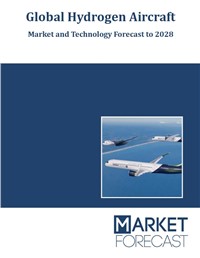A hydrogen aircraft is an aeroplane that uses hydrogen fuel as a power source. Hydrogen can either be burned in a jet engine, or other kind of internal combustion engine, or can be used to power a fuel cell to generate electricity to power a propeller. In recent years, Research into hydrogen as a possible energy carrier to power future zero-emission aircraft has been increasing. But the road to hydrogen-powered aircraft necessitates substantial effort inside the aviation industry and beyond. From hydrogen storage, infrastructure, cost to public perceptions about safety, the aviation sector is working to develop the technology while confronting some major challenges.
Market Forecast’s latest report “Global Hydrogen Aircraft - Market and Technology Forecast to 2029” examines, analyzes, and predicts the evolution of Hydrogen aircraft technologies, markets, and outlays (expenditures) over the next 8 years – 2021 -2029. It also examines the hydrogen aircraft markets geographically, focusing on the top 95% of global markets, in the United States, Europe, and Asia. In this report we analyze the market size of the Global Hydrogen Aircraft Weapons market for the period 2020 – 2028. We primarily focus on the key markets – Americas, Europe, Asia, Middle East and Africa. The European Union, United States and China are emerging markets. Throughout the report we show how To provide the most thorough and realistic forecast, this report provides a twin-scenario analysis, including “steady state”, emergence of Hydrogen aircraft technology.
In this report we have classified Hydrogen aircraft under six (6) major groups. We will research these six major groups and also provide forecast figures from 2021 – 2029.
These major groups are:
1. Region: The regions discussed in this report are:- Americas
- Europe
- Asia
- Middle East
- Africa
- Hydrogen Aircraft – Software Technologies
- Hydrogen Aircraft – Hardware Technologies
- Passenger aerial vehicle
- Cargo aerial vehicle
- Wide body airliners
- Narrow body airliners
- Regional, short-haul, and feederliner aircraft
- Unmanned Aerial Vehicles
- Inter City (100 kms - 500 kms)
- Short Range (1100 kms - 1500 kms)
- Medium Range (2000 kms - 4000 kms)
- Long Range (above 4500 kms)
- E-Commerce Companies
- Airlines
- Military
- Government Organizations
In particular, this report provides an in-depth analysis of the following:
- Overview: Snapshot of the Hydrogen Aircraft tech in the civilian market during 2021-2029, including highlights of the demand drivers, trends and challenges. It also provides a snapshot of the spending with respect to regions as well as segments. It also sheds light on the emergence of new technologies
- Market Dynamics: Insights into the technological developments in the Hydrogen Aircraft market and a detailed analysis of the changing preferences of governments around the world. It also analyzes changing industry structure trends and the challenges faced by the industry participants.
- Segment Analysis: Insights into the various systems market from a segmental perspective and a detailed analysis of factors influencing the market for each segment.
- Regional Review: Insights into modernization patterns and budgetary allocation for top countries within a region.
- Regional Analysis: Insights into the systems market from a regional perspective and a detailed analysis of factors influencing the market for each region.
- Trend Analysis: Key Hydrogen Aircraft markets: Analysis of the key markets in each region, providing an analysis of the various Systems segments expected to be in demand in each region.
- Key Program Analysis: Details of the top programs in each segment expected to be executed during the forecast period.
- Competitive landscape Analysis: Analysis of competitive landscape of this industry. It provides an overview of key companies, together with insights such as key alliances, strategic initiatives and a brief financial analysis.
Reasons to buy
- Determine prospective investment areas based on a detailed trend analysis of the Global Hydrogen Aircraft market over the next eight years
- Gain in-depth understanding about the underlying factors driving demand for different systems segments in the top spending countries across the world and identify the opportunities offered by each of them
- Strengthen your understanding of the market in terms of demand drivers, industry trends, and the latest technological developments, among others
- Identify the major channels that are driving the global small sat business, providing a clear picture about future opportunities that can be tapped, resulting in revenue expansion
- Channelize resources by focusing on the ongoing programs that are being undertaken by the ministries of different countries within the hydrogen aircraft market
- Make correct business decisions based on thorough analysis of the total competitive landscape of the sector with detailed profiles of the top systems providers around the world which include information about their products, alliances, recent contract wins and financial analysis wherever available




